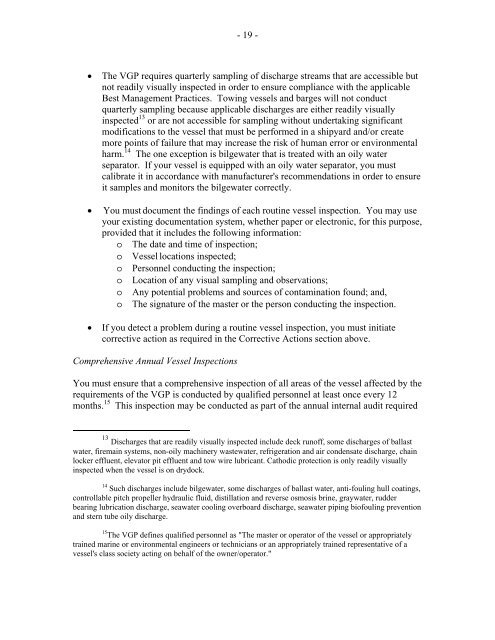AWO Recommended Practice Guide - The American Waterways ...
AWO Recommended Practice Guide - The American Waterways ...
AWO Recommended Practice Guide - The American Waterways ...
You also want an ePaper? Increase the reach of your titles
YUMPU automatically turns print PDFs into web optimized ePapers that Google loves.
- 19 -<strong>The</strong> VGP requires quarterly sampling of discharge streams that are accessible butnot readily visually inspected in order to ensure compliance with the applicableBest Management <strong>Practice</strong>s. Towing vessels and barges will not conductquarterly sampling because applicable discharges are either readily visuallyinspected 13 or are not accessible for sampling without undertaking significantmodifications to the vessel that must be performed in a shipyard and/or createmore points of failure that may increase the risk of human error or environmentalharm. 14 <strong>The</strong> one exception is bilgewater that is treated with an oily waterseparator. If your vessel is equipped with an oily water separator, you mustcalibrate it in accordance with manufacturer's recommendations in order to ensureit samples and monitors the bilgewater correctly.You must document the findings of each routine vessel inspection. You may useyour existing documentation system, whether paper or electronic, for this purpose,provided that it includes the following information:o <strong>The</strong> date and time of inspection;o Vessel locations inspected;o Personnel conducting the inspection;o Location of any visual sampling and observations;o Any potential problems and sources of contamination found; and,o <strong>The</strong> signature of the master or the person conducting the inspection.If you detect a problem during a routine vessel inspection, you must initiatecorrective action as required in the Corrective Actions section above.Comprehensive Annual Vessel InspectionsYou must ensure that a comprehensive inspection of all areas of the vessel affected by therequirements of the VGP is conducted by qualified personnel at least once every 12months. 15 This inspection may be conducted as part of the annual internal audit required13 Discharges that are readily visually inspected include deck runoff, some discharges of ballastwater, firemain systems, non-oily machinery wastewater, refrigeration and air condensate discharge, chainlocker effluent, elevator pit effluent and tow wire lubricant. Cathodic protection is only readily visuallyinspected when the vessel is on drydock.14 Such discharges include bilgewater, some discharges of ballast water, anti-fouling hull coatings,controllable pitch propeller hydraulic fluid, distillation and reverse osmosis brine, graywater, rudderbearing lubrication discharge, seawater cooling overboard discharge, seawater piping biofouling preventionand stern tube oily discharge.15 <strong>The</strong> VGP defines qualified personnel as "<strong>The</strong> master or operator of the vessel or appropriatelytrained marine or environmental engineers or technicians or an appropriately trained representative of avessel's class society acting on behalf of the owner/operator."















